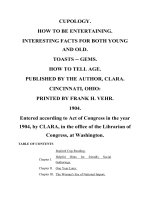How to study enghlish 6 doc
Bạn đang xem bản rút gọn của tài liệu. Xem và tải ngay bản đầy đủ của tài liệu tại đây (69.02 KB, 6 trang )
DISCOVERING HOW YOU LEARN
11
• Order. If you like to do crossword puzzles, fill out forms, work
math problems, or do other activities in an orderly way, you are
probably a sequential learner. Sequential learners need to put
things in a particular order so they can learn them.
• Images. If you make pictures or designs in your head as you’re
looking at or listening to something, you are learning through
images. People who learn through images are usually global learn-
ers. These people like to see the whole picture and often don’t
need to work through individual parts, as sequential learners do.
• Doing. If you like to keep moving—whether it’s the big-move-
ment action of sports or dancing, or a small-movement action
such as doodling, playing an instrument, or needlework, you
might learn best by motion, and be a kinesthetic learner.
Kinesthetic learners learn best when they keep their bodies or
hands moving.
G
ET IN T
OUCH WITH YOUR
STYLE
Here’s an activity using five general styles to help you get in touch with
how you learn.
• Write in your notebook a list of things you like to do, and things
you’re good at. Include the kinds of jobs you enjoy, clubs you
belong to or to which you’d like to belong, and things you haven’t
done but wish you could.
• Make five columns, one for each general learning style: eyes, ears,
order, images, and doing.
• Now take each item from your list and put it in the appropriate
column. Some things might appear in more than one column.
For instance, playing the clarinet could be both doing (the fingers
are doing the walking) and ears (listening).
• Add the number of items in each column. Which columns have
the most? These are the ones that most likely represent your
strongest learning styles.
Find Out!
1.
2.
3.
HOW TO STUDY
12
You’ll probably find ways other than these five that are particularly
helpful to you. What’s important is that you keep looking for connections
between what you do and how you do it. There are as many combina-
tions of learning styles as there are people! The way to find out about
yourself is to pay close attention to when and how you pay close attention.
HOW
DO YOU REMEMBER?
The next time someone gives you a phone number, pay attention to what
you do to try to remember the number. Write in your notebook what
you do.
Do you see the numbers in your head?
Do you say the numbers, perhaps over and over, in your head?
Do you do both?
Do you write the numbers in the air with your finger?
Do you make a picture of the numbers in your head?
Do you hear the tones of the numbers in your head?
Do you put the numbers in certain groupings?
Try It!
1.
2.
3.
DISCOVERING HOW YOU LEARN
13
RIGHT-BRAIN VERSUS LEFT-BRAIN THINKING
Another kind of difference in learning styles has to do with whether the
right side or the left side of your brain is dominant.Your brain hemispheres
crisscross to your hands. This means that if you’re left-handed, the right
side of your brain is probably more developed. If you’re right-handed, you
probably rely on the left side of your brain more than the right. Each side
has its own jobs to do, although the two sides do communicate with each
other. You might find traits of how you think in both sides.
Right-brain thinkers (who are usually left-handed) tend to be creative
types. They are good at coming up with new ideas. Many artists, poets, and
composers are right-brain thinkers.
Left-brain thinkers (who are usually right-handed) are more orderly
in their thought processes. There are many more left-brain thinkers than
right-brain thinkers, so you’ll find left-brain thinkers in all kinds of
occupations.
Each kind of thinking has its own strengths. While the right-brain
thinker will come up with a good idea for the theme of a birthday party,
the left-brain thinker is the one you would want to count on to organize
the party: send out the invitations, get the food, and find people to help
decorate. The right-brain thinker will be good at creative games like
charades, while the left-brain thinker will be good at games that require
logic and following rules, like checkers or bridge. The right-brain thinker
loves to dance and may even make up new steps to go with the music.
The left-brain thinker may like to dance, too, because he or she will find
it easy to learn the steps of the waltz, mambo, or electric slide.
Right-brain thinkers like the rhythm of poetry. Left-brain thinkers like
figuring out the meaning of a poem.
As you’ll see in the next section, it matters whether you’re a right-
brain or a left-brain thinker because each kind of thinking requires dif-
ferent kinds of study habits.
So what’s your next step? To find out what kind of thinker you are!
R
IGHT OR
LEFT?
Are you left-handed (right brain) or right-handed (left brain)? This will
give you a clue, but a lot of left-handed people have some left-brain ten-
Find Out!
Find Out!
HOW TO STUDY
14
dencies, and right-handed people may have right-brain tendencies. So try
this exercise to see where you fall.
• Go back to the list of favorite things you made in the exercise
earlier in this chapter.
• Circle any items that have to do with rhythm, music, art, or
creative thinking.
• Underline any items that have to do with solving a problem,
organizing something, or thinking logically.
Your circles are connected with right-brain thinking. Your under-
lines are connected with left-brain thinking. Which do you have more of?
S
TUDY TIPS FOR
LEFT-BRAIN THINKERS
If in the exercise above you had more underlines than circles, then you’re
probably more comfortable with logical and abstract ways of relating to
the world around you.
Logical Thinking
You have a structured, organized way of thinking. Concepts called
syllogisms, like, “If A = B, and B = C, then A = C” come easily to you.
If this is you, here are some ways you can use your left-brain
strengths in studying:
• Find similarities. Look for connections within or between the
topics you’re studying. For example: words that look or sound
alike, laws made for similar reasons or that have similar impact.
• Write or record what makes them similar in your notebook or
on tape.
• Ask yourself what the similarities could mean. Write or record
your answers.
• Use numbers in writing or speaking to classify the importance of
the similarities.
DISCOVERING HOW YOU LEARN
15
Abstract Thinking
You don’t always want to know exactly what something is because you
prefer to figure it out yourself. You like algebra better than arithmetic.
The meanings in short stories, novels, or poems come easily to you.
If this is you:
• Begin in the middle—whether you’re reading a text, reviewing
your notebook, or listening to taped notes.
• Write or record what you know for sure and what questions come
to mind. Use symbols. For example, if you’re studying monar-
chies in history class, you could draw a crown in the margin of
your notebook. Use colors, or different intonations in a recording,
to help you remember the connections between your questions
and the topics you know for sure.
• Search the text or taped recording for your answers, then write
them down or record them.
• Write or record a summary using your symbols, colors, or
intonations.
STUDY TIPS FOR RIGHT-BRAIN THINKERS
If in the exercise above you had more circles than underlines, you’re
probably more comfortable with literal and creative ways of relating to
the world around you.
Literal Thinking
You need to see something to be convinced. You may prefer math and
geometry to algebra, and non-fiction to short stories and novels.
If this is you, here are some ways you can use your right-brain
strengths in studying:
• Remind yourself of what you know for sure. Check illustrations
and charts carefully before, during, and after you read. If there
aren’t any in the text, make them!
• Choose and use colors to identify characters or themes in a story,
and different procedures in algebra or math (for example: green
could be adding; red, subtracting; black, multiplying; and so on).
HOW TO STUDY
16
Creative Thinking
If you’re a right-brain thinker, you’re probably pretty good at coming up
with ideas.
If this is you:
• Use your imagination. Pretend the text is a speech or a play and
you’re the announcer or actor. Come up with your own ideas on
this!
Rhythm
Musical rhythms, songs, or the beats in poetry come easily to you.
If this is you:
• Tap your foot or fingers as you read your text as if it were a song
or poem. This works with numbers, too.
Art
You like to look at or make drawings, sculptures, or paintings.
If this is you:
• Draw pictures of what something you’re reading means to you.
Turn the text into your own cartoon.
You’ve come a long way already. Now you know which side of the
brain dominates your thinking and you have used that knowledge to find
learning styles that will help you learn more efficiently. In the next three
chapters, you’ll be exploring those styles, one by one.
WHAT IF ENGLISH ISN’T YOUR FIRST
LANGUAGE?
O.K. Now you have a general idea of what your learning styles are. But
you spoke another language before you learned English. Reading in
English takes a little longer than reading in your native language. Some
native English speakers talk a little too fast for you to understand them.
What can you do?
The trickiest part of learning a new language is the simplest. CLOSE
YOUR EYES. Let your ears do the work. No matter what kind of a learner









